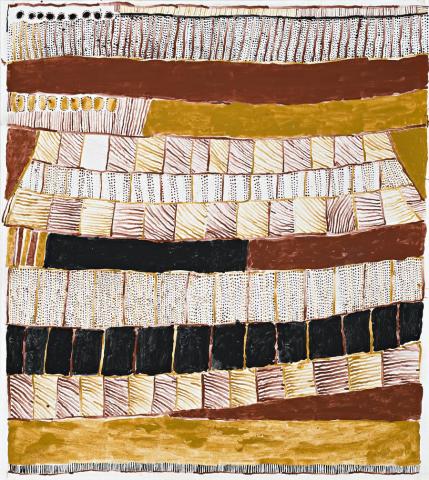UNTITLED, 2001
Kutuwulumi (Kitty Kantilla) Purawarrumpatu
natural earth pigments and synthetic binder on canvas
96.0 x 86.0 cm
inscribed verso: artist's name and Jilamara Arts and Crafts cat. 25/01
Jilamara Arts and Crafts, Melville Island (stamped verso)
Short St Gallery, Broome
Private collection, Western Australia
Sotheby's, Sydney, 28 – 29 July 2003, lot 87
Private collection, New South Wales
Ochre, Short St Gallery, Broome, 9 – 30 August, 2001 Kitty Kantilla, The Ian Potter Centre: NGV Australia at Federation Square, Melbourne, 27 April – 19 August 2007, Art Gallery of New South Wales, Sydney, 7 December – 21 January 2008, cat. 68 (label attached verso)
Ryan, J., Kitty Kantilla, National Gallery of Victoria, Melbourne, 2007, p. 57 (illus.)
Kitty Kantilla (Kutuwulumi Purawarrumpatu) was the first Tiwi artist to be the recipient of a retrospective exhibition at a major Australian art gallery. Held at the National Gallery of Victoria and the Art Gallery of New South Wales between April 2007 and January 2008, the exhibition was a celebration of the work of one of the most prominent Tiwi artists. Kantilla continues to be regarded as one of Australia's most accomplished indigenous artists, her work attracting widespread acclaim and she is credited with significantly raising the profile of Tiwi art.
Kantilla was born in Yimpinari country, Melville Island, and commenced her artistic career in the late 1980s at the age of fifty, producing ironwood sculptures for two group exhibitions in Sydney and Melbourne, in association with Tiwi Pima on Bathurst Island. In 1989, she moved to Milikapiti on Melville Island beginning a long association with Jilamara Arts and Craft. Kantilla's work represents the expression of cultural memory passed down through matrilineal heritage. Her father taught her the jilamara - 'I've still got the design in my head.' Refusing a widows pension, Kantilla successfully forged a living from her practice and often referred to her work as 'pumpuni jilamara - a good design'.1
Based on the geometric, abstract designs of Tiwi art, Kantilla created work across a variety of mediums; paper, canvas, bark, ironwood sculptures, as well as limited edition prints - all in the distinctive Tiwi palette of rich and creamy ochre tones. Every mark conveys traditional meanings, especially those of the Tiwi burial ceremony, Pukamani. Central to Tiwi spiritual beliefs, geometric patterns are applied to both participants and burial poles.
Kitty's skin group was rain, her dance was fire: these two elements are delicately balanced in her work. 'Her dots, as steady as gentle rain, form a constant rhythm of detailed marks against which dynamic bursts of big colour, fire, provide moments of intensity'.2
1. Ryan, J., Kitty Kantilla, National Gallery of Victoria, Melbourne 2007 p. 75
2. ibid. p. 75
